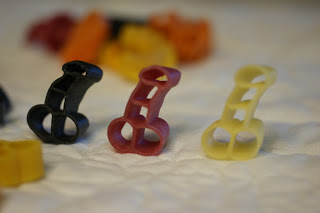Let's face it, pasta is usually nothing more than wheat and water, pressed into some fancy shapes. Obviously this belies the long culinary history of pasta. all the way from Italy. There are estimated to be over 350 varieties of pasta, many of which named after a dizzying array of things. Body parts seem a common theme with ears (orecchiette), tongues (linguine), moustaches (mostaccioli, another name for penne) all having pasta shapes named after them. Invertebrates get a bit of a look in too, with snails (lumache), squid (calamarata), worms (vermicelli) and butterflies (farfalle) all having a starring role. Then there is the really odd like bibs (bavette), cooking pots (lasagne) and thimbles (ditalini). Sadly there aren't any obviously rude official regional pasta varieties, as would fit the nature of this blog, though, as I pointed out previously, the word penne is just one "n" too many away from meaning penis. Then, I consulted everybody's friend Google and found that there is actually a dick-shaped pasta variety.
Al dente
Anyway, moving back to the recipe in hand, when considering vegetarian dishes, pasta is a perfect base and the Italian love of fresh vegetables make for some delicious possibilities. This concoction is no exception and really is a cracking little recipe. Aubergines, garlic, chilli, basil and a few crunchy pine nuts mean it's stupidly simple and quick to put together.
TIMING
Preparation: 5 minutes
Cooking: 30 minutes
INGREDIENTS
4 tbsp olive oil plus additional for pouring on
2 tbsp pine nuts
4 cloves of garlic, crushed
1 large aubergine (around 300g in size), chopped into 2cm dice
2 tbsp tomato puree
1 tsp dried chilli flakes
Salt and black pepper to taste
Handful of fresh basil leaves
150-200g dried pasta (penne or fusilli work)
RECIPE
Heat the oil in a large pan and throw in the pine nuts
Fry them for a couple of minutes, until they are golden brown before removing them with a slotted spoon
Add the garlic to the hot oil and fry for 2 minutes before adding the aubergine.
Fry for another 10-15 minutes until the aubergine pieces start to colour
Add the tomato puree, black pepper and salt to taste and continue to cook for another 10-15 minutes, adding the odd tablespoon of water if it gets too dry
Meanwhile, cook the pasta and drain.
Turn the pasta into the pan with the cooked aubergine, mix, and add the pine nuts.
Finally, tear the basil leaves and add to the pasta and aubergines and stir, adding additional olive oil to give the dish a glossy look.
Serve up with some nice crusty bread.
NOTES
Probably because my pedigree is more factory-made by Clarks in northern England than hand-made in Milan, I don't have much time for the whole idea that a certain shape of pasta must be served with a certain type of sauce. In this instance, the dried penne and fusilli I used (there was half a portion of fusilli left so had to add some penne from a new packet) held onto the sauce well. I've also served this with fresh tagliatelli and it works just as good.
The basil and pine nuts really make this dish. Dried basil is not a substitute for fresh leaves as the taste is very different. Pine nuts could possibly be swapped for other nuts, perhaps peanuts or cashews, but the dish will be missing the subtle coniferous fragrance that they impart.
One rare problem with pine nuts is pine mouth syndrome. This can happen after eating some pine nuts when, as I found out one time, you end up with a bitter taste in your mouth for a few days after eating the kernel. It does fade, but you don't enjoy your dinners for a few days as a result.
Contrary to urban myth, pasta was not brought to Italy by Marco Polo coming back from China, but by Arabs from North Africa. Is nothing sacred? Next thing you know they'll be claiming Arabs gave the world mathematics like algebra or made early advances in astronomy. Oh, wait, they did.











